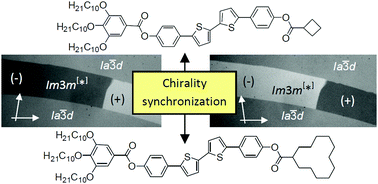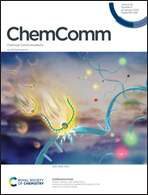Controlling spontaneous mirror symmetry breaking in cubic liquid crystalline phases by the cycloaliphatic ring size†
Abstract
Rod-like molecules combining a fork-like triple chain end and a cycloaliphatic apex are introduced as a new design concept for materials with broad ranges of bicontinuous cubic (Cubbi) phases. By ring expansion from n = 4 to 12 a sequence of three Cubbi phases is observed; the achiral double gyroid la![[3 with combining macron]](https://www.rsc.org/images/entities/char_0033_0304.gif) d phase, a chiral “Im3m” phase and an achiral re-entrant la
d phase, a chiral “Im3m” phase and an achiral re-entrant la![[3 with combining macron]](https://www.rsc.org/images/entities/char_0033_0304.gif) d phase. The chiral “Im3m” phase is formed if the helical twist between the molecules along the networks is in the range of 8.6°–9.5°, either for the individual compounds or their mixtures.
d phase. The chiral “Im3m” phase is formed if the helical twist between the molecules along the networks is in the range of 8.6°–9.5°, either for the individual compounds or their mixtures.



 Please wait while we load your content...
Please wait while we load your content...